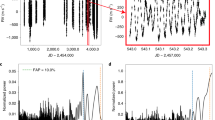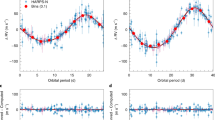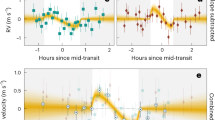Abstract
The spin of a planet arises from the accretion of angular momentum during its formation1,2,3, but the details of this process are still unclear. In the Solar System, the equatorial rotation velocities and, consequently, spin angular momenta of most of the planets increase with planetary mass4; the exceptions to this trend are Mercury and Venus, which, since formation, have significantly spun down because of tidal interactions5,6. Here we report near-infrared spectroscopic observations, at a resolving power of 100,000, of the young extrasolar gas giant planet β Pictoris b (refs 7, 8). The absorption signal from carbon monoxide in the planet’s thermal spectrum is found to be blueshifted with respect to that from the parent star by approximately 15 kilometres per second, consistent with a circular orbit9. The combined line profile exhibits a rotational broadening of about 25 kilometres per second, meaning that β Pictoris b spins significantly faster than any planet in the Solar System, in line with the extrapolation of the known trend in spin velocity with planet mass.
This is a preview of subscription content, access via your institution
Access options
Subscribe to this journal
Receive 51 print issues and online access
$199.00 per year
only $3.90 per issue
Buy this article
- Purchase on Springer Link
- Instant access to full article PDF
Prices may be subject to local taxes which are calculated during checkout


Similar content being viewed by others
References
Lissauer, J. J. & Kary, D. M. The origin of the systematic component of planetary rotation: I. Planet on a circular orbit. Icarus 94, 126–159 (1991)
Dones, L. & Tremaine, S. On the origin of planetary spins. Icarus 103, 67–92 (1993)
Johansen, A. & Lacerda, P. Prograde rotation of protoplanets by accretion of pebbles in a gaseous environment. Mon. Not. R. Astron. Soc. 404, 475–485 (2010)
Hughes, D. W. Planetary spin. Planet. Space Sci. 51, 517–523 (2003)
Pettengill, G. H. & Dyce, R. B. A Radar determination of the rotation of the planet Mercury. Nature 206, 1240 (1965)
Correia, A. C. M. & Laskar, J. The four final rotation states of Venus. Nature 411, 767–770 (2001)
Lagrange, A.-M. et al. A probable giant planet imaged in the β Pictoris disk. Astron. Astrophys. 493, L21–L25 (2009)
Lagrange, A.-M. et al. A giant planet imaged in the disk of the young star Pictoris. Science 329, 57–59 (2010)
Chauvin, G. et al. Orbital characterization of the β Pictoris b giant planet. Astron. Astrophys. 542, A41 (2012)
Brogi, M. et al. The signature of orbital motion from the dayside of the planet τ Bootis b. Nature 486, 502–504 (2012)
de Kok, R. et al. Detection of carbon monoxide in the high-resolution day-side spectrum of the exoplanet HD 189733b. Astron. Astrophys. 554, A82 (2013)
Sparks, W. B. & Ford, H. C. Imaging spectroscopy for extrasolar planet detection. Astrophys. J. 578, 543 (2002)
Konopacky, Q. M., Barman, T. S., Macintosh, B. A. & Marois, C. Detection of carbon monoxide and water absorption lines in an exoplanet atmosphere. Science 339, 1398–1401 (2013)
Kaeufl, H.-U. et al. CRIRES: a high-resolution infrared spectrograph for ESO’s VLT. Proc. SPIE 5492, 1218–1227 (2004)
Gontcharov, G. A. Pulkovo compilation of radial velocities for 35495 Hipparcos stars in a common system. Astron. Lett. 32, 759–771 (2006)
Lecavelier Des Etangs, A. et al. β Pictoris: evidence of light variations. Astron. Astrophys. 299, 557 (1995)
Lecavelier Des Etangs, A. et al. Beta Pictoris light variations. I. The planetary hypothesis. Astron. Astrophys. 328, 311–320 (1997)
Cuk, M. & Stewart, S. Making the Moon from a fast-spinning Earth: a giant impact followed by resonant despinning. Science 338, 1047–1052 (2012)
Currie, T. et al. A combined Very Large Telescope and Gemini study of the atmosphere of the directly imaged planet, β Pictoris b. Astrophys. J. 776, 15 (2013)
Bonnefoy, M. et al. The near-infrared spectral energy distribution of β Pictoris b. Astron. Astrophys. 555, A107 (2013)
Binks, A. S. & Jeffries, R. D. A lithium depletion boundary age of 21 Myr for the Beta Pictoris moving group. Mon. Not. R. Astron. Soc. 438, L11–L15 (2014)
Konopacky, Q. M. et al. Rotational velocities of individual components in very low mass binaries. Astrophys. J. 750, 79–93 (2012)
Crossfield, I. et al. A global cloud map of the nearest known brown dwarf. Nature 505, 654–656 (2014)
Baraffe, I., Chabrier, G., Barman, T. S., Allard, F. & Hauschildt, P. H. Evolutionary models for cool brown dwarfs and extrasolar giant planets. Astron. Astrophys. 402, 701–712 (2003)
Arsenault, R. et al. MACAO-VLTI: an adaptive optics system for the ESO VLT interferometer. Adapt. Opt. Syst. Technol. II 4839, 174–185 (2003)
Vogt, S. & Penrod, G. Doppler imaging of spotted stars: application to the RS Canum Venaticorum star HR 1099. Publ. Astron. Soc. Pacif. 95, 565–576 (1983)
Vogt, S., Hatzes, A., Misch, A. & Kurster, M. Doppler imagery of the spotted RS Canum Venaticorum star HR 1099 (V711 Tauri) from 1981 to 1992. Astrophys. J. 121 (suppl.). 547–589 (1999)
Barnes, J., Collier Cameron, A., James, D. & Donati, J.-F. Doppler images from dual-site observations of southern rapidly rotating stars – I. Differential rotation on PZ Tel. Mon. Not. R. Astron. Soc. 314, 162–174 (2000)
Vogt, S., Penrod, G. & Hatzes, A. Doppler images of rotating stars using maximum entropy image reconstruction. Astrophys. J. 321, 496–515 (1987)
European. Southern Observatory. CRIRES data reduction pipeline http://www.eso.org/observing/dfo/quality/CRIRES/pipeline/pipe_gen.html (2011)
Rucinski, S. in Precise Stellar Radial Velocities, IAU Colloquium. 170. (eds Hearnshaw, J. B. & Scarfe, C. D. ) 82–190 (Astronomical Society of the Pacific, 1999)
Brogi, M. et al. Detection of molecular absorption in the dayside of exoplanet 51 Pegasi b? Astrophys. J. 767, 27 (2013)
Birkby, J. L. et al. Detection of water absorption in the day side atmosphere of HD 189733b using ground-based high-resolution spectroscopy at 3.2 μm. Mon. Not. R. Astron. Soc. 436, L35–L39 (2013)
Borysow, A., Jorgensen, U. G. & Fu, Y. High-temperature (1000–7000 K) collision-induced absorption of H2 pairs computed from the first principles, with application to cool and dense stellar atmospheres. J. Quant. Spectrosc. Radiat. Transf. 68, 235–255 (2001)
Borysow, A. Collision-induced absorption coefficients of H2 pairs at temperatures from 60 K to 1000 K. Astron. Astrophys. 390, 779 (2002)
Madhusudhan, N. C/O ratio as a dimension for characterizing exoplanetary atmospheres. Astrophys. J. 758, 36 (2012)
Moses, J. I., Madhusudhan, N., Visscher, C. & Freedman, R. S. Chemical consequences of the C/O ratio on hot Jupiters: examples from WASP-12b, CoRoT-2b, XO-1b, and HD 189733b. Astrophys. J. 763, 25 (2013)
Rothman, L. S. et al. HITEMP, the high-temperature spectroscopic database. J. Quant. Spectrosc. Radiat. Transf. 111, 2139–2150 (2010)
Rothman, L. S. et al. The HITRAN 2008 molecular spectroscopic database. J. Quant. Spectrosc. Radiat. Transf. 110, 533–572 (2009)
Brandl, B. et al. METIS: the thermal infrared instrument for the E-ELT. Proc. SPIE 8446, 84461M (2012)
Maiolino, R. et al. A community science case for E-ELT HIRES. Preprint at http://arxiv.org/abs/1310.3163 (2013)
Lee, S. et al. GMTNIRS (Giant Magellan Telescope near-infrared spectrograph): design concept. Proc. SPIE 7735, 77352K (2010)
Acknowledgements
We thank T. de Zeeuw for granting Director’s Discretionary Time on the VLT to perform these observations (292.C-5017(A)). I.A.G.S. acknowledges support from an NWO VICI grant. R.J.d.K. acknowledges the NWO PEPSci programme.
Author information
Authors and Affiliations
Contributions
I.A.G.S. designed the project with help from B.R.B., R.J.d.K., M.B. and J.B. The analysis was led by I.A.G.S. and he wrote the first version of the manuscript. I.A.G.S. and B.R.B. made the connection with the European Extremely Large Telescope. R.J.d.K. constructed the planet atmosphere models. B.J.B., R.J.d.K., M.B., J.B. and H.S. discussed the analyses and results, and commented on the manuscript.
Corresponding author
Ethics declarations
Competing interests
The authors declare no competing financial interests.
Extended data figures and tables
Extended Data Figure 1 Model spectra and cross-correlation signals.
The model spectral templates (left panels) and the resulting cross-correlation signals (right panels) for (from top to bottom) a high-VMR CO model, a low-VMR CO model, the previous model with an added high VMR of H2O, an H2O-only mode and a CH4 model. Atmospheric pressures are in units of bars.
Extended Data Figure 2 Simulated E-ELT observations.
We simulated observations of a rotating spot on β Pictoris b as would be made by the future 39-m European Extremely Large Telescope. Such observations could be conducted with the planned METIS40. The three panels on the left show the position of the spot at times approximately 1 h apart. The spot was given a surface brightness twice that of the rest of the planet’s atmosphere. The right-hand panel shows the difference between three cross-correlation signals with respect to the average cross-correlation profile as indicated by the dashed curve (scaled down by a factor of 25), with the spot signature moving from −15 to +5 km s−1.
PowerPoint slides
Rights and permissions
About this article
Cite this article
Snellen, I., Brandl, B., de Kok, R. et al. Fast spin of the young extrasolar planet β Pictoris b. Nature 509, 63–65 (2014). https://doi.org/10.1038/nature13253
Received:
Accepted:
Published:
Issue Date:
DOI: https://doi.org/10.1038/nature13253
This article is cited by
-
The discovery space of ELT-ANDES. Stars and stellar populations
Experimental Astronomy (2024)
-
On the behaviour of spin–orbit connection of exoplanets
Nature Astronomy (2023)
-
Alien suns reversing in exoplanet skies
Scientific Reports (2022)
-
Detecting life outside our solar system with a large high-contrast-imaging mission
Experimental Astronomy (2022)
-
The theory of figures of Clairaut with focus on the gravitational modulus: inequalities and an improvement in the Darwin–Radau equation
São Paulo Journal of Mathematical Sciences (2020)
Comments
By submitting a comment you agree to abide by our Terms and Community Guidelines. If you find something abusive or that does not comply with our terms or guidelines please flag it as inappropriate.



